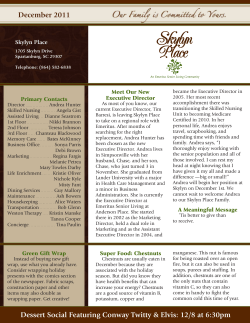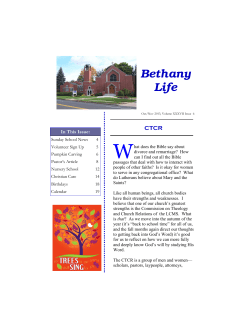
Network traffic engineering University of Roma “Sapienza” Lecturer: Andrea Baiocchi
University of Roma “Sapienza” DIET Network traffic engineering Lecturer: Andrea Baiocchi DIET - University of Roma “Sapienza” E-mail: andrea.baiocchi@uniroma1.it URL: http://net.infocom.uniroma1.it/corsi/ing_traffico/ Lecture 1 Introduction to network traffic engineering a.a. 2013/2014 2 Traffic engineering: what is it? • Traffic engineering deals with the application of probability and optimization theories to analysis and design of service systems. • Analysis – Calculate/estimate performance • Design – Evaluation of which resources to use and how much of them. • Service systems – Input-output function with given quality specs – Examples: protocol, router, server, network Network traffic engineering - Andrea Baiocchi - a.a. 2013/2014 3 Network Traffic Engineering • Applied to networking – From isolated network elements to protocols, to networks • Service system abstraction – Allows generale results, applicable to different domains • e.g., transportation networks, logistics, power distribution networks, supply chains and inventory management, workflow systems – Methodologies are applicable to different problems • e.g., Markov chains and processes, renewal processes, queueing theory, convex optimization, graph theory Network traffic engineering - Andrea Baiocchi - a.a. 2013/2014 4 NTE target • The aim of NTE is to build mathematical models, given a service system specification: – Structure, policies, intrinsic service capacity – Statistical description of demand • service request arrivals • amount of required service • The model gives mathematical rules to tie together: – DEMAND (USERS) – SYSTEM CAPACITY (RESOURCES) – PERFORMANCE METRICS (QUALITY) Network traffic engineering - Andrea Baiocchi - a.a. 2013/2014 5 Example • A base station of a cellular network, covering a single cell • Demand assignment resource management, with equal rate communication channels assigned for a whole session • Arrivals? • Service? • Appropriate model? • Performance metrics? Network traffic engineering - Andrea Baiocchi - a.a. 2013/2014 6 Application objective • The final objective is to design service system that meet given service grade constraints at a minimum cost (minimization of required resources) for the given/expected demand. • To that purpose, we need: – Methods to quantify and forecast demand (service characterization, measurements); – Method to evaluate the system capacity (e.g., models of system, lab measurements, filed trials, simulations); – Methods to evaluate the service grade offered by a given configuration of the system with given demand – Methods for recovery actions, to restore the capabilities of the systems after congestion and or mulfunctioning. Network traffic engineering - Andrea Baiocchi - a.a. 2013/2014 7 Example (follows) • Minimize number of channels for given set-up failure probability • Hand-offs: how can we deal with them? • Demand quantification: mobility pattern, service preferences, session duration – More complex if more flexibility allowed: different rates, priorities • Evaluation of service grade: Erlang model • Recovery actions: some channels are turned-off; the base station fails (e.g., power failure) Network traffic engineering - Andrea Baiocchi - a.a. 2013/2014 8 Erlang loss model usage Network traffic engineering - Andrea Baiocchi - a.a. 2013/2014 9 The art of modeling • From system description to a mathematical model Key: simplifying assumptions and hypotheses • Requires: – In-depth technical knowledge of system working and context; – Mathematical skills to adopt the most useful models. • A system model can be analyzed by – Theoretical means (e.g., queueing theory) – Computer aided simulations – Lab/field experiments Network traffic engineering - Andrea Baiocchi - a.a. 2013/2014 10 Example (follows) • Aim: optimize use of spectrum • Full knowledge of radio resource management – MAC protocol or multiple access scheme – Types of service, requirements. – Radio channel modeling (attenutation, shadowing, fading) – Physical layer modeling (e.g., Shannon limit capacity) • Full knowledge of user behavior patterns – Mobility – Traffic demand – Desired QoE/QoS, willingness to pay Network traffic engineering - Andrea Baiocchi - a.a. 2013/2014 11 NTE approaches pros and cons APPROACH Theoretical model grossly simplified gain insight Simulation model laborious, costly many details accounted for Lab/field trial very expensive, inflexible, costly the ultimate word Network traffic engineering - Andrea Baiocchi - a.a. 2013/2014 12 Modeling approach Observation Model Analysis Results Check Network traffic engineering - Andrea Baiocchi - a.a. 2013/2014 13 NTE tasks Network traffic engineering - Andrea Baiocchi - a.a. 2013/2014 14 NTE tools Network traffic engineering - Andrea Baiocchi - a.a. 2013/2014 15 Example • Let us now work out an example: delay equalization of a packet stream • Applications: streaming audio/video • Technical approach: – Introduce additional, variable delay at receiving end • Issues: – Late packets – Receiver buffer sizing Network traffic engineering - Andrea Baiocchi - a.a. 2013/2014
© Copyright 2025












